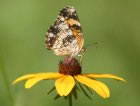Find a Butterfly
Silvery Checkerspot
Chlosyne nycteis
Named
Doubleday and Hewitson, 1847

Identification
Wingspan: 1 3/8 - 1 3/4". Best distinguished from its close relative the Harris‘ Checkerspot by the characteristics of the underwing. In Harris‘ the background color is a rich reddish hue, and the contrasting cream-colored spots appear in fairly regular rows; in Silvery the general impression is of a pale yellowish tone or big whitish panels blotched irregularly with brown. This checkerspot could also be confused with females of the spring form of Pearl Crescent with its blotchy silvery-spotted hind wing below. This confusion can be resolved by looking at the row of spots that parallels the margin of the hindwing above. In Pearl Crescent these dots are solid black; in Silvery Checkerspot they tend to be more crescent- or gumdrop-shaped and to have pale centers. Compare also Silver-bordered Fritillary.
Distribution
Mainly eastern North America from Manitoba and east Texas east to Nova Scotia and Georgia; absent from the coastal plain in the southeastern and gulf states. There are also disjunct populations in the Rocky Mountains. In New England there are a few localized colonies, e.g. in York County, Maine and around New Haven Connecticut.
Status in Massachusetts
Though common throughout much of its range, the Silvery Checkerspot is rare and local in Massachusetts and was not found during the Atlas period (1986-90). This conforms with its historical status, Scudder (1889) calling it "a very rare insect" in New England, while Farquhar (1934) says "not a common species". There are early Massachusetts records from Blandford, Holyoke, Lenox, Sutton, and Williamstown (Scudder, 1889). More recent records include: 1 July 1981, Great Barrington (Berkshire Co.), R. Wendell; 24 May 1984, Tyngsboro (Middlesex Co), R. Robbins. Scudder notes that most of the New England localities "are upon elevated ground". Maximum: The records in the literature and by recent collectors are all of single butterflies.

Flight Period in Massachusetts
Mainly June to early July in New England based on the meager number of records and few localities where it occurs regularly. Extreme dates: 24 May 1975, Tyngsboro (Middlesex Co.), R. Robbins, and 2 September 1936, Lunenburg (Middlesex Co.), from Clark (1951).
Larval Food Plants
Reported from a variety of composites throughout its range, especially sunflowers and asters. At the Connecticut and New York sites larvae are associated with Woodland Sunflower (H. divaricatus) (Schweitzer and Tudor (pers.comm.).
Adult Food sources
Uses New Jersey Tea often in Connecticut (Schweitzer, pers comm.); Pavulaan (pers. comm.)has observed adults , especially males, imbibing moisture from wet dirt; also recorded visiting dung.
Habitat
Silvery Checkerspot seems to prefer moist meadows and streamsides; however, it is also found in openings with bordering shrubbery, open woods, and along roadsides. It also occurs near heavily developed areas such as city parks.
Life Cycle
EGG: Whitish green, barrel-shaped and ribbed. OVIPOSITION: Eggs are laid in groups of about 100 on the underside of the leaves of the food plant. LARVA: Dark brown or black with yellow lateral stripes and white side spots and covered with bristly spines. The caterpillars emerge from hibernation in May; they feed in groups but do not spin webs. CHRYSALIS: Highly variable in general color -- white, yellow, pink, brown to blackish --with darker streaks and blotches; surface covered with rows of conical tubercles. PUPATION: 10-15 days. OVERWINTERING STAGE: Third instar larva. According to Scott (1986) the overwintering larva has "a special reddish brown skin".
Males are reported to "loop" behind and above females (Scott, 1986) during courtship near larval food plants; the typical flight style is slow with alternating "flaps and glides" (Opler and Krizek, 1984).
Notes
The ecology and distribution of this species in the Northeast merit further study. If active breeding sites are discovered in Massachusetts, the species should be considered for listing under the state endangered species act and management considerations investigated.
Account Author
Chris Leahy



